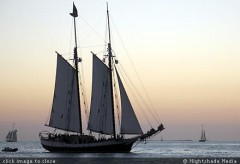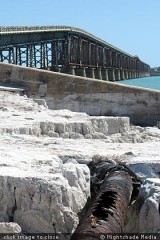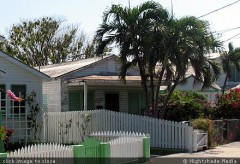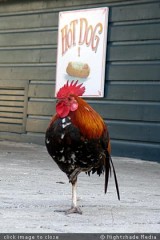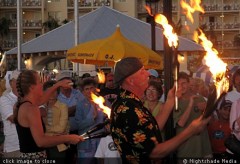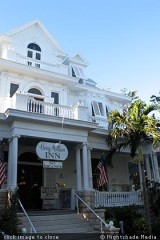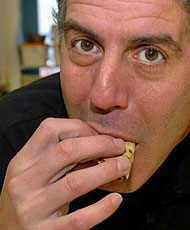Key West … key lime everything!
The most popular airline routes in the Winter are between Northeastern cities and Florida. Most everyone that lives with a lengthy cold Winter wants a break for sunshine and the ability to wear a t-shirt for a while again. But what is a viable destination in a state whose charm and history has been largely eradicated by “progress” and rabid development? Disney World and other theme parks or concrete high-rise resort hotels with crowded beaches are simply not for everyone. If you are looking for Florida sunshine in an area that retains some truth to its? roots while still meeting the needs of current travelers, Key West might be an answer.
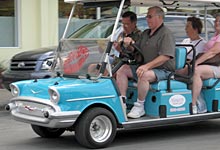
Key West Car
Key West is a small island located at the southernmost point in the United States. Of course there is a tourist marker near the actual “Southern-Most” spot to serve as a photo location. Key West has been attracting tourists long enough to know the silly things people are drawn to. There are certainly other tourist gimmicks and gadgets such as the theme park style “trains” that tour people around the island but this is done just as they have for many years. There is also a large business in renting bicycles, motor scooters and often rather funny electric golf carts. But the real advantage to the southern most location of Key West is not the distinction for the tourist marker but rather that the weather in “The Keys” tends to be a bit warmer and less inclined to rain during the winter months than the rest of the Florida Peninsula.
The original natural state of Key West was not exactly a tropical paradise. There were no pristine beaches (they have basically been created to resemble those in Miami) and swaying coconut palms but rather the island had a low rocky seashore, was completely lacking fresh water and had barely a hint of topography with maybe about 16 feet above sea level to the highest ground. But it did have an excellent deep harbor and was in a good location to service ships in transit between the gulf coast and Cuba. The island was purchased by an entrepreneur named John Whitehead and a partner John Simonton for two thousand dollars. It had been owned by a Spaniard who was given the island in 1815 by the Spanish crown for helping to put down a rebellion in Spanish-held Florida. The sale was in 1821 just after the fledgling United States acquired Florida and the Keys from Spain.
The early development of Florida’s tourism back in the late 1800’s was largely due to the efforts of Henry Flaggler, a retired Standard Oil tycoon turned railroad and hotel magnet. After developing rail service as far south as Palm Beach and building several famous hotels like The Breakers and the Royal Poinciana to cater to exclusive travelers, a few years of unusual cold weather prompted him to keep moving the rail line even farther south. Ultimately he connected the Florida Keys with the tremendous undertaking of constructing miles of elevated track to span the water between the Keys. Following the seven year project, Flaggler rode the first train into Key West in 1912, only a year before his death. The old rail bridges were first converted to roadways and then replaced with the current system of bridges but have been left as interesting relics in some areas and as walking and fishing piers in others. In at least one location, to reach the small island of Pigeon Key, one end of the original bridge is still in use.
Many of the old small private houses and the larger guest houses remain in Key West and formed the core of what we found most pleasing for a short winter break. Wandering through the small streets spotted with tropical foliage in short sleeves was very relaxing compared to the 6 lane boulevards and gated private ?communities? of coastal Florida. There was certainly some evidence of storm damage to the larger trees in Key West but they were not as badly damaged by the severe hurricanes of 2005 as might have been possible based upon news coverage.
In some ways, Key West resembles southern Louisiana and New Orleans in particular. There are many wooden houses, some long and narrow single story houses of the “shotgun style” and quite a large number of historic homes with overhanging front porches running the full width of the second story. With Spanish Moss hanging from the trees it is easy to picture the deep south. But of course, to be technical, this really is the deepest south and the tree will be a tropical specie rather than a Live Oak.
The resemblance between Key West and New Orleans doesn’t stop with residential architecture. Key West certainly has its bawdy side which is largely focused on the bars and clubs along Duval Street. Entertainment is available in large doses for gay, lesbian, straight, bisexual and uncertain. Booze flows as freely as sexual attitudes on Duval Street so it is easy to stroll the main drag and find a place that fits your interests to let off some steam or just grab a good table at one of the many outdoor restaurants and watch the street traffic. At the same time, there is little or no “in-your-face” display of these freedoms on the street and only the most intolerant straight people are likely to be uncomfortable. The gay men’s revue at La Te Da has been a favorite for many years.
Duval Street ends to the west at Mallory Square, a large open space that serves as the daily host to the traditional sunset celebration. Thousands of visitors gather daily at sundown to enjoy the antics of street performers, munch on a conche fritter and hope to witness the famous “green flash” as the sun hits the sea. I admit to having been distracted by the dubious performance of a “trained” dog just as the “green flash” might have been possible. The raw talent level of many of the card-table mystics and performers, including their pets, is dubious at best however they are all good humored and entertaining. One lanky acrobat who barely fit into his superman outfit made use of a municipal trash receptacle to perform high jumps. He was doing so from a raised platform that would have allowed a 5 year old to clear the can’s height but when he pulled the onlookers closer by saying he “wanted it to look like he had a good crowd on hand” the laughter exposed the real purpose of his act. The jugglers shown were good and nobody needed any burn treatment after the show.
So what about Key Lime? The Key Lime is a small lime that was initially grown in the Florida Keys, having been brought to the New World from Malaysia, likely by the Spanish. It has a slightly different flavor and aroma than the normal Persian Limes that typically finish off one’s gin and tonic and found immortality in a pie that needed no ice, no fresh milk or refrigeration (none of which was available in Key West before the 1930’s). Needless to say anything is obtainable with a “Key Lime” theme in the Key West gift shops. Key Lime toothpaste, Key Lime soaps and shampoo, Key Lime cigars … well maybe not yet, but soon!
It is the Key Lime Pie that started all of this and the inventor is said to have been known as “Aunt Sally” who worked as the cook for William Curry in his Key West mansion. This is the version adhered to by Edith Amsterdam, owner of The Curry Mansion Inn and agreed upon by many others. But such legends are elusive and it may be interesting to note that Edith also owns a well known summer home on the St. Lawrence River where the origins of Thousand Island Dressing are equally as important and often disputed. Regardless of the Key Lime Pie inventor’s identity, we were most curious to know if the local versions of this well known desert would shine and who might make the most tasty. For what it’s worth, Key Lime Pie was ordered for desert almost every place we went and Louie’s Backyard restaurant on Waddell Street gets our nod as being the best of those sampled.

